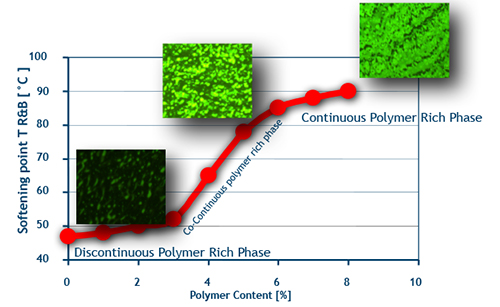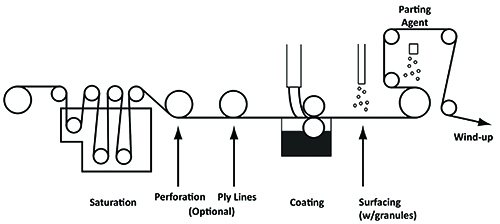By Bob Klutz, Eileen Dutton and Jonathan Davis
You may be most familiar with modified asphalt for paving, but modified asphalt has been used for roofing applications since the 1970s.
Asphalt is a cost-effective material for construction and waterproofing, but roofing products are subjected to wide and rapid temperature swings – even more so than paving. Also, buildings move!
So, the ability of the roofing product to flex and relax is required. In asphalt paving, the structural material is the rock whereas, in roofing, the structural material is the asphalt itself.
For these reasons, asphalt used in roofing is nearly always modified in one way or another. The most common modification is oxidation through air blowing. This has the overall effect of reducing the temperature susceptibility of the asphalt. The low-temperature properties worsen some but the high-temperature properties improve considerably. Air-blown asphalt is used predominantly for shingles, but also for low slope built up roofing (BUR).
After air blowing, the most common modifiers are styrene-butadiene-styrene copolymer (SBS) and atactic polypropylene (APP). Both of these additives swell, absorbing much of the asphalt so the polymer becomes the dominant phase (Figure 1). These blended products are typically called “modified bitumen” or “mod bit.”

Each of the three types of modification has relative advantages and disadvantages. The following table shows some typical characteristics of each type of modification in roofing asphalt.
The roofing market
There are two segments of the roofing market, and the products and assemblies for those markets are quite different. The difference is based on purpose. Low slope roofing, typically for commercial buildings, uses roofing products for waterproofing. Steep slope roofing, typically for houses, needs roofing products for water shedding.
The impact of the different requirements is evident in the market sizes in cost versus volume. According to a National Roofing Contractors Association (NRCA) 2015 survey, steep slope roofing was 26 percent of the dollar value of the whole market, but 70 percent of the volume by area. So, low slope roofing costs are roughly six or seven times as much as steep slope. Waterproofing is more difficult.
Both roofing markets have a variety of solutions – asphalt, as well as other materials. Again, from the NRCA 2015 survey, the largest segments of the low slope market were: thermoplastic polyolefin, or TPO, (30%); EPDM rubber (25%); mod bit (12%) and BUR (7%). In the mod bit category, there are a variety of product types with both modifiers. The modified asphalt is coated on a fiber mat, then surfaced on the top with granules and on the bottom with a dusting agent or adhesive layer with release. The mat may be fiberglass, polyester or a combination. A typical production line for mod bit materials is shown in Figure 2.

While the paving world is driven by agency specifications, the building world is driven by building codes. These building codes follow ASTM International test methods and specifications. Thus, the various types of roofing products are produced to meet the various ASTM requirements. There are seven different ASTM specifications for mod bit low slope products alone covering the different modifiers, mat types and application methods.
There are also numerous ASTM test methods covering asphalt roofing products. These test methods cover a wide range of properties including mass, thickness, tensile properties, tear strength, low-temperature flex, dimensional stability, high-temperature stability granule adhesion, plywood adhesion, bond strength, nail seal, fastener pull through, waterproof integrity and wind uplift resistance.
On the steep slope side, NRCA found that asphalt shingles are 59 percent of the market while metal roofing is 23 percent. Though only a small percent of the shingle market is polymer modified shingles, modified asphalt is used extensively for the tab and laminating adhesives used to hold shingles together. Modified asphalt is also used in waterproofing underlayments to prevent water ingress.
Polymer modified shingles
Most people don’t look much at roofs around them. But there is a group of people that get excited by the looks of roofs and these are the roofing manufacturers. Most can tell you, just by looking, the type and even the manufacturer of the roofing product. Typically, people look at storms and see how much damage there is. But roofing manufacturers and their industry groups look at the damage caused by storms and evaluate what can be done to minimize or eliminate the damage. Many areas of the United States, like Alaska, are known to experience severe storms, but there are also places along the coasts that experience high wind events for extended periods of time.
To combat these events, the first SBS polymer-modified shingle was manufactured. It was a simple 3-tab shingle. It was about 20 years later that other companies started to produce this type of shingle and almost thirty years later the idea of polymer modified shingles really took off. Because of the success seen in Alaska, and the fact that the shingle could withstand up to 100 mph winds without being sealed, the shingle was used in Miami-Dade County, Florida after Hurricane Andrew hit in 1992.
But first, a little history lesson on asphalt shingles. Asphalt shingles were first used in the late 1800s. At that time, cotton rag was used as the base for the shingle. It was saturated and coated with oxidized asphalt, with monochrome granules sprinkled on the hot asphalt. These would be cut by hand and placed on the roof to protect the roof from the elements. The asphalt used was patented by Byerly in 1894, and, with only minor changes, this is the type of asphalt that most shingles manufactured today are still using. This process relies on softer fluxes, which are in shorter supply now than they have been, or on chemically-modified asphalts. Instead of cotton rag, shingles are now made with fiberglass reinforcements, and instead of a single granule color, there are multitudes of colors available with different design elements.
So, if this has been working for 100 years, why do something different? In more recent years, there has been an increasingly larger number of severe storms. Combine severe storms with a larger population living in severe storm areas, and the result is that insurance companies are paying billions of dollars in claims on failed roofing materials as a consequence of high winds, hurricanes or hail. For example, a friend living in Texas had their roof replaced three times in seven years due to hail storms. The insurance companies are interested in roofing materials that will last so they only have to replace roofs in these higher risk areas only once in seven to ten years instead of two to three times in that period.
Polymer-modified shingles start with what are essentially paving grade asphalts as the base, which represents a wider range of asphalt availability and modifies them with a higher polymer content than typical road paving applications. These modified asphalts may vary by company, and may or may not contain recycled material. Polymer-modified shingles have been shown to be more resistant to hail and high winds than oxidized asphalt shingles (modified sealants have improved the wind performance of oxidized shingles). Granule adhesion is improved with polymer modification, so the asphalt is shielded longer from ultraviolet rays. They are essentially the same construction as oxidized shingles, but with modified asphalt.
The IBHS (Insurance Institute for Building and Home Safety), Texas Department of Insurance and insurance companies are showing increased interest in polymer-modified shingles. A Texas customer who replaced their roof three times in seven years due to storm damage is now enjoying their sixth year with polymer modified shingles that have weathered multiple hailstorms.
Waterproofing underlayments
Another use for modified asphalt in roofing applications is in waterproofing underlayment. An underlayment is a layer of material placed between the roof deck and the exterior surfacing material (typically shingles, wood shake, metal, tile, slate or cap sheet). It is a critical, though often overlooked, component of any complete roofing system.
The underlayment helps keep the deck dry during installation until the surfacing material can be applied. On a finished roof, it will provide secondary protection from wind-driven rain, ice damming and other types of moisture penetration. It can also help a roof system meet required fire ratings and minimize picture framing, which is the visible outline of deck panels caused by irregularities in roof decking thickness.
Underlayment can be divided into two broad categories based upon the technique by which it is affixed to the roof deck. Mechanically attached membranes rely on staples, nails, screws or other types of fasteners to hold them in place. Self-adhered underlayment is comprised of an integrated adhesive layer, usually a polymer-modified asphalt, which bonds directly to the deck beneath it. Self-adhered materials are generally used in valleys, eaves and rakes (sloped sides) where water can back up due to clogged gutters or the accumulation of snow, ice, leaves and other debris. Mechanically attached sheets are used in the field of the roof. However, in certain areas where storms and high wind are prone to lift or remove the roof surface, building codes may require self-adhered underlayment to be used on the entire roof deck.
Self-adhered underlayment must perform in a wide range of environments. The adhesive should remain pliable and adhere to the roof deck during installation at temperatures as low as 40°F (4°C), while maintaining thermal stability at conditions above 200°F (93°C). Furthermore, the material should remain completely waterproof, even after penetration by fasteners used to attach the roof surfacing material.
Asphalt modified with a small amount of styrenic diene block copolymer (approximately 3-12% by weight) has been used extensively in the industry to achieve the desired performance. Specifically, these mixtures exhibit the small thermal susceptibility needed to provide low- temperature adhesion and high-temperature cohesion, as well as strength, toughness and elastic recovery. The compound most commonly used in this application is a styrenebutadiene-styrene (SBS) block copolymer. Combinations with vinyl and acrylic olefins or other polyolefins are also used. The exact blend will depend on the desired physical properties and applications.
Many factors must be considered when formulating these blends. The chemistry of both the base asphalt and polymer strongly affects the efficacy of polymer modification. Both the extent and stability of polymer dispersion in the asphalt matrix can be established with ultraviolet microscopy (qualitative), and/or with “cigar tube” separation tests and creep-recovery measurements on a rheometer (quantitative). Regarding the choice of styrenic polymer, molecular structure (radial/ branched vs. linear), coupling efficiency, molecular weight distribution, degree of hydrogenation and vinyl content can be optimized to improve blending and yield the necessary attributes in the finished product. Other additives may be combined with the styrenic polymers to further enhance adhesion, improve compatibility of the asphalt-polymer blend or reduce the viscosity of the mixture to facilitate manufacturing.
Self-adhered underlayments are integral to a roofing system and must meet many requirements to ensure suitability for use. Polymer-modified asphalt is a key component of this composite material, and careful selection of both polymer and asphalt are essential to certify sound performance throughout the service life of the roof. This information was derived from presentations made at the “Modified Asphalt Workshop” held during the Annual Meeting of the Association of Modified Asphalt Producers (AMAP) in February 2018.
Bob Kluttz is Staff Research Chemist with Kraton Polymers. Eileen Dutton is Vice President of Technical Services with Malarkey Roofing Products. Jonathan Davis is Senior Engineer with Owens Corning Science and Technology.